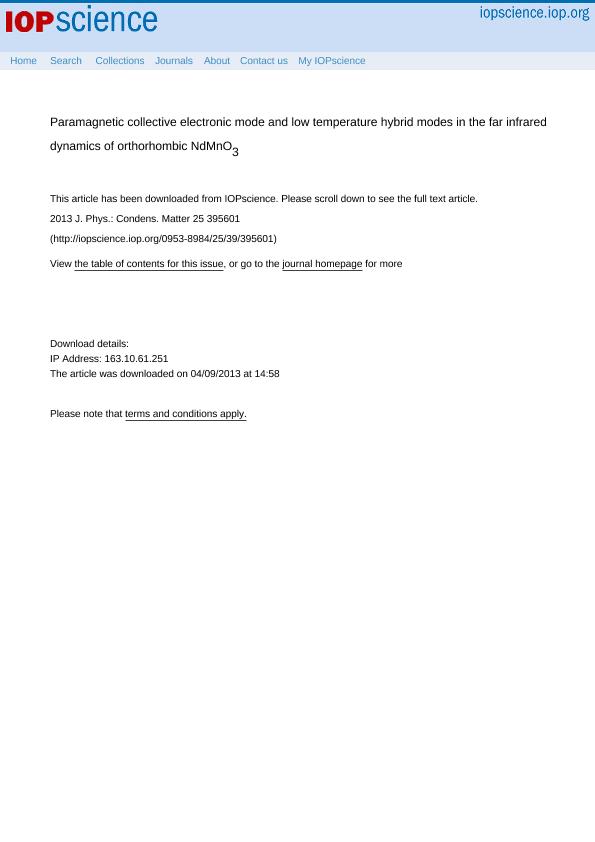Mostrar el registro sencillo del ítem
dc.contributor.author
Massa, Nestor Emilio

dc.contributor.author
del Campo, Leire
dc.contributor.author
de Sousa Meneses, Domingos
dc.contributor.author
Echegut, Patrick
dc.contributor.author
Martinez Lope, Maria Jesus
dc.contributor.author
Alonso, Jose Antonio
dc.date.available
2017-09-18T19:25:31Z
dc.date.issued
2013-08
dc.identifier.citation
Massa, Nestor Emilio; del Campo, Leire; de Sousa Meneses, Domingos; Echegut, Patrick; Martinez Lope, Maria Jesus; et al.; Paramagnetic collective electronic mode and low temperature hybrid modes in the
far infrared dynamics of orthorhombic NdMnO3; IOP Publishing; Journal of Physics: Condensed Matter; 25; 39; 8-2013; 395601-395610
dc.identifier.issn
0953-8984
dc.identifier.uri
http://hdl.handle.net/11336/24493
dc.description.abstract
We report on the far- and mid-infrared reflectivity of NdMnO3 from 4 to 300 K. Two main features are distinguished in the infrared spectra: active phonons in agreement with expectations for the orthorhombic ${\mathrm{D}}_{2\mathrm{h}}^{1 6}$–Pbnm (Z = 4) space group remaining constant down to 4 K and a well defined collective excitation in the THz region due to eg electrons in a d-orbital fluctuating environment. We trace its origin to the NdMnO3 high-temperature orbital disordered intermediate phase not being totally dynamically quenched at lower temperatures. This results in minute orbital misalignments that translate into randomized non-static eg electrons within orbitals yielding a room-temperature collective excitation. Below TN ~ 78 K, electrons gradually localize, inducing long-range magnetic order as the THz band condenses into two modes that emerge pinned to the A-type antiferromagnetic order. They harden simultaneously down to 4 K, obeying power laws with TN as the critical temperature and exponents β ~ 0.25 and β ~ 0.53, as for a tri-critical point and Landau magnetic ordering, respectively. At 4 K they match known zone center spin wave modes. The power law dependence is concomitant with a second order transition in which spin modes modulate orbital instabilities in a magnetoelectric hybridized orbital–charge–spin–lattice scenario. We also found that phonon profiles also undergo strong changes at TN ~ 78 K due to magnetoelasticity.
dc.format
application/pdf
dc.language.iso
eng
dc.publisher
IOP Publishing

dc.rights
info:eu-repo/semantics/openAccess
dc.rights.uri
https://creativecommons.org/licenses/by-nc-sa/2.5/ar/
dc.subject
Collective Excitation
dc.subject
Far Infrared
dc.subject
Multierroics
dc.subject
Spin Waves
dc.subject.classification
Otras Ciencias Físicas

dc.subject.classification
Ciencias Físicas

dc.subject.classification
CIENCIAS NATURALES Y EXACTAS

dc.title
Paramagnetic collective electronic mode and low temperature hybrid modes in the
far infrared dynamics of orthorhombic NdMnO3
dc.type
info:eu-repo/semantics/article
dc.type
info:ar-repo/semantics/artículo
dc.type
info:eu-repo/semantics/publishedVersion
dc.date.updated
2017-09-14T13:53:33Z
dc.journal.volume
25
dc.journal.number
39
dc.journal.pagination
395601-395610
dc.journal.pais
Reino Unido

dc.journal.ciudad
Londres
dc.description.fil
Fil: Massa, Nestor Emilio. Consejo Nacional de Investigaciones Científicas y Técnicas. Centro Científico Tecnológico Conicet - La Plata. Centro de Química Inorgánica "Dr. Pedro J. Aymonino". Universidad Nacional de La Plata. Facultad de Ciencias Exactas. Centro de Química Inorgánica "Dr. Pedro J. Aymonino"; Argentina
dc.description.fil
Fil: del Campo, Leire. Universite d’Orléans; Francia
dc.description.fil
Fil: de Sousa Meneses, Domingos. Universite d’Orléans; Francia
dc.description.fil
Fil: Echegut, Patrick. Universite d’Orléans; Francia
dc.description.fil
Fil: Martinez Lope, Maria Jesus. Instituto de Ciencia de Materiales de Madrid; España
dc.description.fil
Fil: Alonso, Jose Antonio. Instituto de Ciencia de Materiales de Madrid; España
dc.journal.title
Journal of Physics: Condensed Matter

dc.relation.alternativeid
info:eu-repo/semantics/altIdentifier/doi/http://dx.doi.org/10.1088/0953-8984/25/39/395601
dc.relation.alternativeid
info:eu-repo/semantics/altIdentifier/url/http://iopscience.iop.org/article/10.1088/0953-8984/25/39/395601/meta;
Archivos asociados
